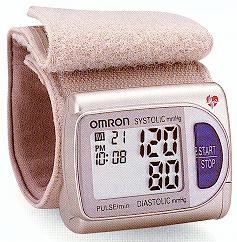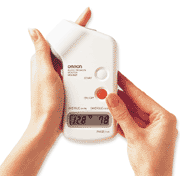pressure monitor
Blood pressure monitor
pressure monitor
Do you need a printer to actually print out the blood
pressure information?
(To show your doctor or prove to your spouse?)
If you can't write… or remember the readings, there are
blood pressure
devices that actually come with a little printer to print
the blood pressure
measurement on paper for you.
Get lower blood pressure readings
by choosing
the best blood pressure monitor
for you… take this quiz to find out.
Ask yourself
these questions to find out
which blood pressure monitor may be best for you?
BLOOD PRESSURE MONITOR
QUIZ
Here are some of the questions you might want to ask yourself
before
purchasing any home blood pressure equipment.
Remember, there are many different brands and at least
3 different types of
blood pressure monitors for sale on the market today.
They include the
regular blood pressure cuff, which wraps around your
bicep (upper arm)
like your doctor uses… a digital blood pressure monitor
such as the
Omron wrist blood pressure monitor, which snaps or Velcro's
over your
wrist… or the finger blood pressure meter which only
requires you
to point your finger through a small opening to detect
your
blood pressure reading.
The following questions will help you to identify which
home blood
pressure meter is best for you . You want to buy
a blood pressure kit
that is easy for you to use. Physical limitations
may make it difficult for
some people to use the blood pressure cuff device… while
people who
want a most accurate reading may not want to use the
finger blood
pressure machine. Answer the following questions
to learn more
about your choices.
What is your reason for owning
a home blood
pressure monitor?
Do you have high blood pressure?
Low blood pressure?
Every home blood pressure kit will give you accurate blood
pressure readings,
but it is important to note that some are much more sensitive
than others.
If you are looking for a device to measure low
blood pressure, it is important
to know that the blood pressure cuff device is the most
sensitive to
low blood pressure… and the finger blood pressure device
the least sensitive
for taking a low blood pressure reading. If you
have low blood pressure,
you may want to consult your physician about this choice.
How old are you?
While age is really not the factor here… there is a good
chance that if you
are looking for a home blood pressure monitor, you are
older, and therefore
may have limitations in what you can do.
It is best to take an honest look at some of those limitations
before buying a home blood pressure device.
Do you have any physical limitations?
Physical limitations may include many things.
Here are some you may want to think about.
What are your physical limitations?
The object here is to compare taking your own blood pressure
with other
activities that take the same kind of knowledge, skill
and/or finger dexterity.
Can you:
Set your own watch… clean your own glasses, button your
own shirt,
tie your own shoe? Can you dress yourself?
Can you put on a bra,
underwear, buckle your belt? Do you have any neck
problems?
Can you see your upper arm? Can you stand and hold
a paperback
book under your arm?
If you said "no" to any of these questions, you may not
want to
use the blood pressure cuff, as it is much more difficult
to place and
control than the new wrist blood pressure monitor or
finger blood
pressure monitor that are for sale today. Do you
have another person
who will be installing it on your
arm? If so, the cuff will give you the
most accurate blood pressure reading.
Physical size limitations
How big are you?
Blood pressure cuffs come in different sizes. What
size are you?
There are specific measurements for small medium and
large sizes.
You must measure your arm to determine the size of the
cuff you need.
Extremely thin persons, with petite arms may even need
a child's cuff.
Difficulty for large people vs
thin people
to attach the blood pressure
cuff.
Can you reach your opposite arm comfortably?
If this is a struggle, the blood pressure cuff may not
be the best
choice for you. Struggling to put the blood pressure
cuff on your arm
may raise you blood pressure due to the frustration,
and not give you an
accurate normal blood pressure reading even when you
do finally
get the blood pressure measurement.
Wrist monitors attach with a plastic or Velcro band and
one size fits all.
Finger blood pressure monitors are also one size fits
all.
Eyesight- how well do you see
at close range?
How difficult will it be to attach the blood pressure
device
to your body and then read the blood pressure meter.
Questions you may want to ask yourself.
Can you read your watch or a large print book?
Can you see your arm, wrist and finger?
The blood pressure meter that connects to these devices
and actually
gives you your blood pressure information come in different
sizes
and shapes. Make sure the numbers are large enough
for you to
read at the distance you must read them.
Also, many types of blood pressure instruments have the
blood pressure
meter connected directly to the blood pressure device
itself, while others
have a separate meter connected by a small wire or hose.
You may
want to think about these factors if you plan to carry
the
blood pressure monitor around with you.
The compact wrist blood pressure monitor may be the best
choice
if you're always on the go. You can wear it like
a watch and not
have to worry about any dangling wires or loose hoses.
Dexterity – how is your finger
dexterity?
Compare the ease of attaching a blood pressure device
to your body.
The blood pressure cuff is the most difficult to install…
but will give the most accurate results if installed
correctly.
The wrist blood pressure monitor balances accuracy with
ease of use…
and the finger blood pressure monitor may be the least
accurate
(in comparison to other types)
Accuracy
Keep in mind that it is not
the exact number you get as a blood
pressure measurement that is always most important.
It is the range
of blood pressure readings you
get each day and how they compare
to your normal blood pressure
reading that is most important.
So it is good to know your blood pressure
normal reading to make immediate comparisons.
It is also not important that your blood pressure gauge
give the exact
same blood pressure readings as every other blood pressure
device.
Your monitor may differ from other monitors by a few
pounds...
and this does not really matter. This is like weighing
yourself on your
bathroom scale... and then going to your doctor.
It may not give you the
exact same number (weight) as the scale at your doctors
office.
So matching the numbers is not what is most important.
It is more important to show "fluctuations" in your weight
loss or gain.
The difference in one or two pounds when using different
scales
is really not as relevant as whether you are losing or
gaining the weight.
Similarly, it is more important just to learn about the
"fluctuations" in
your blood pressure readings and how much they differ
from your
normal blood pressure reading, than it is to expect the
same exact
blood pressure reading from two different blood pressure
instruments.
My suggestion
is for you to take your new blood pressure device with you
the next time you see your doctor, and have him calibrate
the variations
by comparing it with his own blood pressure device, and
keep a personal
blood
pressure chart for them to see your "fluctuations".
Blood pressure monitoring can save your life.
Storage
Consider the case that the blood pressure device comes
in.
Most blood pressure devices are packed in a small soft
case, while others
have a hard case. Consider these differences as
far as where and how
you will carry it with you, and what kind of protection
it will need.
If you don't like the case, but do like the device…
don't let that make your decision for you. You
may just want to consider
buying a better case for it (as you would do to carry
good glasses).
I suggest something such as a small padded camera case
from your local
variety store. In it you could carry the blood
pressure monitor, pen and a
small notebook and some of your blood pressure
medications for emergencies.
Security
Since blood pressure instruments are fairly expensive
and small, it is also
a good idea to write down the serial number and permanently
mark
your blood pressure device with your name and phone number
in case it is
mixed up with others of the same type or brand… and to
identify it if it is
ever lost or stolen. A black magic marker will
usually do the job.
Privacy
The wrist and finger blood pressure devices offer more
privacy of use
than the cuff type. These will also allow you to
help others by easily
allowing them to share your new tool by allowing them
to easily do their
own blood pressure privately. They also seem to
be a little less
problematic and easier to use.
Quality vs on sale advertising
Buy a quality tool not a toy Your life may depend
on it.
A discount blood pressure monitor is better than no blood
pressure
monitor at all. But consider its importance to
your overall health
and peace of mind if you own a quality blood pressure
monitor.
Your pharmacist can be of great value in helping you determine
the best blood pressure monitor for you. Don't
be afraid to
ask for assistance.
Guarantees on these devices run from 1 year – 5 years
Be sure to look for this information before making your
purchase.
Does the device have an AC jack or does it only run on
batteries?
AC adapters are about $35.00 for those devices that can
use them.
Can you manually pump up the blood pressure cuff or is
it
only done automatically.
Buying your new blood pressure tester at the local drug
store
will most likely include instructions and personal assistance,
including installing the batteries and checking to see
that the device
will fit on your arm... right in the store.
Ask the pharmacist.
Good luck on your new purchase.
If you learn anything while shopping that you think may
be helpful to others, please drop me a line at
Marie@sunsetvideo.org
Home
- Top of page - Continue
the tour
* Disclaimer
The information contained on these pages is for general
reference purposes only.
It is not a substitute for professional medical advice.
You should always seek the advice of your
physician before starting any new treatment.
Sunset relaxation therapy (SRT) is a stress management
technique
designed to reduce stress and lower blood pressure.
Feel free to tell your doctor about Sunset Relaxation
Video and Sunset Relaxation Therapy.
SRT has been accepted by medicare, with doctors orders,
as a therapeutic, psychological measure
and stress management technique to instantly reduce stress
and lower blood pressure.
This stress management tool is now being used by many
home health agencies.
If you think you have a stress disorder or have a difficult
time managing or dealing with stress,
talk to your doctor about beginning some sort of stress
management training.
The sunset relaxation and stress management technique
may give you exactly
the stress relief you are looking for
Stress relief and stress reduction are extremely
important if you have high blood pressure.
If your doctor has any questions about the Sunset relaxation
method
you can have him contact me directly at:
Marie@sunsetvideo.org

 ..........
.......... ..........
..........